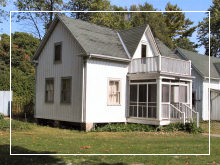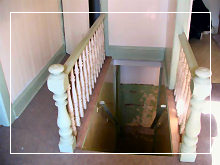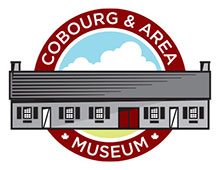THE BUILDING AND ITS CONDITION
The building, referred to as “the cottage”, is a storey and a half wooden structure measuring 30 feet by 18 feet in plan and thought to have been a modest residential structure built in the late 1860s to early 1870s. It has been examined by Rob Mikel, a well respected authority on heritage buildings and family histories, especially in the Cobourg area where he was born, and by Peter Stokes, the heritage architect who guided the 1970s restoration of Victoria Hall in Downtown Cobourg.
 The building, along with a storey and a half driving shed of approximately the same dimensions, is believed to have been built close to the waterfront on the Illahee Lodge property at the south end of Ontario Street. Later both buildings were moved to the northern border of the property where the cottage was set on brick piers and the shed was set on a concrete slab.
The building, along with a storey and a half driving shed of approximately the same dimensions, is believed to have been built close to the waterfront on the Illahee Lodge property at the south end of Ontario Street. Later both buildings were moved to the northern border of the property where the cottage was set on brick piers and the shed was set on a concrete slab.
Over the years, the interior of the cottage was modified to accommodate at least two different uses. These modifications included adding electrical wiring and a hard-wired fire alarm system, adding first and second floor bathrooms, turning the kitchen into a common room and adding a screened-in front porch with a balcony above served by a second floor exterior door which replaced a window. Fibre tiles covered the plaster ceilings and wood panelling covered the plaster walls. Narrow hardwood flooring had been added covering the original wood floor. At a later date all the floors were carpeted. Along the bottom of the board and batten siding rot was evident in some areas.
Despite its age, the interior woodwork was in excellent condition.
 As a result of having been supported by a stone foundation at some time in its past, the heavy perimeter 10 inch by 10 inch timber wood sills showed evidence of significant rot along 40% of their 92 foot length. Over 16 feet of this length the rot had penetrated to half the timber depth.
As a result of having been supported by a stone foundation at some time in its past, the heavy perimeter 10 inch by 10 inch timber wood sills showed evidence of significant rot along 40% of their 92 foot length. Over 16 feet of this length the rot had penetrated to half the timber depth.
THE COTTAGE IS MOVED TO THE SITE OF THE COBOURG & AREA MUSEUM
In 2006 the Cobourg Museum Foundation developed a site plan for its first project, developing the “barracks” building into an exhibit hall and its site into the Sifton-Cook Heritage Centre. The plan included a 30 foot by 20 foot storey and a half administration building to be constructed at the east end of its site. The CMF began to collect heavy timber framing and barn board to be used in its construction.
In the same year Kevin Doble bought the Illahee Lodge property. In September of 2007, he and his development company, West Colony Bay, offered to donate the cottage to the CMF and the shed to the adjacent Calcutt property, adjacent to the CMF site. After a tour of the “barracks” and an explanation of our goals, Mr Doble volunteered to pay for the cost of moving both buildings. Since dimensions of the cottage and the fact it was a heritage building fit the needs of the museum, the CMF accepted Mr Doble’s generous offer.
In November 2007 the CMF was allowed three minor variances by the Committee of Adjustment in its approval of the final location of the cottage on the site.
West Colony Bay engaged the services of Laurie McCullouch Building Movers of Whitby and in the Spring of 2008, McCullouch moved the buildings to the west edge of the property next to Ontario Street and placed them on wooden cribs. In the meantime the CMF approached the companies whose wires would have to be raised along the route of the move and asked if they would donate their costs in support of built-heritage preservation and the future museum. All four companies agreed to do so. As a result, Bell Canada, COGECO Cable, Lakefront Utilities and Cobourg Fiberoptic Networks Inc are recognized as Corporate Sponsors.
The move of both buildings took place simultaneously on July 29, 2008 and the cottage was placed on wood cribs awaiting the construction of a new foundation.
In the meantime a Building Code conflict was discovered between the proposed location of the cottage and nearby high voltage hydro wires. After exploring a number of options, a second site for the building was decided upon which included the added benefit of using the building as the entrance to the site. Lakefront Utilities agreed to grant an easement on their adjacent property and the zoning variance needed was applied for to the Cobourg Committee of Adjustment in October 2008.
THE RENOVATION OF THE COTTAGE
Starting Early October 2008, work was done on the interior of the cottage, including: repairing the areas with wood rot; building a foundation and installing underground water, sewage and electrical lines to the street; re-shingling the roof with hand-split wood shingles; adding strength to the first and second floor structure to allow public occupancy; removing all plaster and rewiring and refinishing the walls and ceilings; building a gift shop and an accessible uni-sex bathroom; refinishing the board and batten siding and adding a protected front porch; installing off-set hinges on the front door along with an entrance ramp to make the building wheelchair accessible.




